I’m fascinated with paper money.
I love how beautiful the banknotes of other nations are.
I love the rich history you can learn by seeing who, or what, a country puts on its paper money.
And I’m always a little saddened when I see the design of our banknotes. We take the term “greenback” a little too seriously. They’re all the same size. Until Harriet Tubman appears on the $20 bill, there are no women. There hadn’t been a woman on any of the United States’ currency since 1978 when Susan B. Anthony was on the dollar coin.
C’mon folks. Our money is sooooooo boring.
They’re so boring, designers have reimagined them and the new bills look so much sexier.
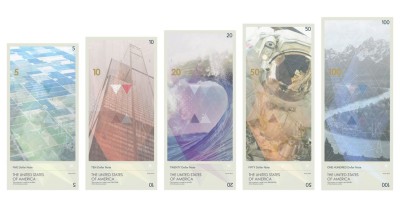
Here are the obverse side of our bills, reimagined by Travis Purrington, and shared in an article on The Verge back in 2014.
If you were to go back in time… to the days of yore… our money was a little bit cooler, especially when you consider the technology available back then. What you didn’t have in terms of printing and dyes you made up with denominations. 🙂
Table of Contents
A Brief History of US Currency
Before we get into the bills themselves, we’ve had a lot of different names written on our currency. You are most familiar with Federal Reserve Note, it’s written on the top of every bill today. A Federal Reserve Note (FRN) is legal tender and, when printed and put into circulation, are liabilities of the Federal Reserve Banks and an obligation of the United States.
Before FRNs, there were United States Notes (1862-1971), or Legal Tender Notes, and were the longest issued type of paper money. The United States Notes were authorized as fiat currency, which meant they didn’t have the backing of any physical commodity. They are still valid currency but haven’t been issued since 1971.
Demand Notes (August 1861 – April 1862) preceded United States Notes and had green backs, hence the term “greenbacks.” If you know your history, you’ll note this was during the Civil War – the US Government printed Demand Notes to help pay for expenses. This was also the first time that the US Government began printing money for widespread circulation.
OK – so now we know about Federal Reserve Notes, United States notes, and Demand Notes.
Now we have certificates – Silver and Gold certificates. These are not fiat currency, these are bills that are backed by a physical commodity (silver or gold). Gold certificates were issued between 1863 and 1933 while silver certificates were issued between 1878 and 1964.
Now, not every type of bill had high denominations. For example, for silver certificates, you only had $500 and $1,000 bills. Gold certificates ran the whole gamut, from $500 to $100,000. Federal Reserve Notes had all but the $100,000.
In each case below, I just chose one that I thought looked the best. 🙂
$100,000 US Banknote
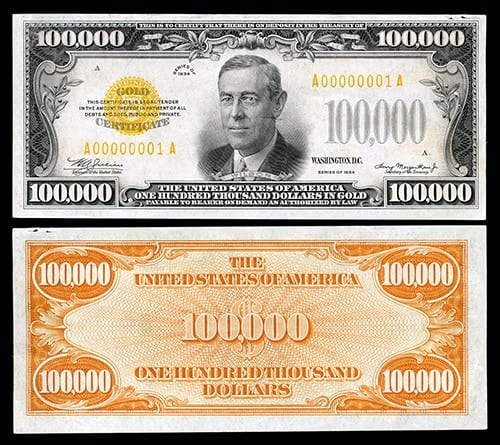
We had to start with the Big Boy.
The largest denomination bill ever produced by the United States was the $100,000 bill, featuring Woodrow Wilson. The last time it was printed was back in 1945 and in 1969, all banknotes above $500 were discontinued.
The $500, $1000, $5000, and $10000 are all floating out there in circulation, though mostly in the hands of collectors, and are legal tender. The $100,000 is a special case, it was never generally circulated, and cannot be legally held by collectors.
It looks like Monopoly money!
$10,000 US Banknote
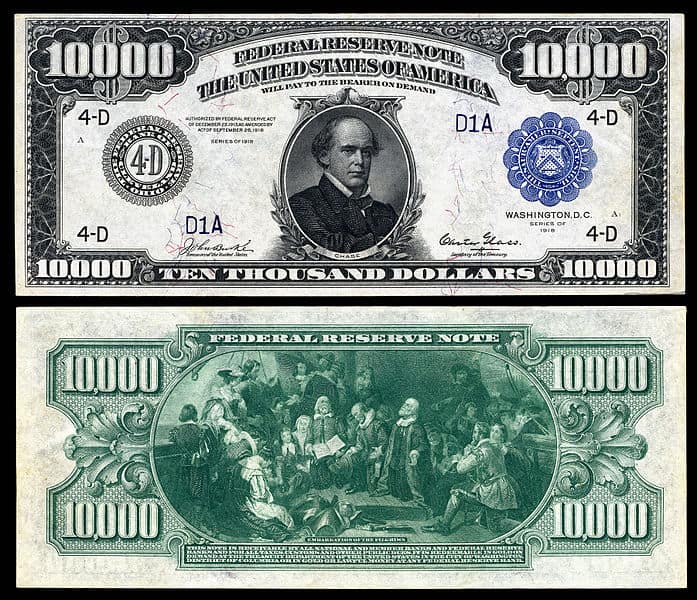
There were several $10,000 notes, the one pictured above is a Federal Reserve Note; there are a series of Gold Certificates too and the back of the bills vary. They all feature Salmon P. Chase, who served as the 25th Secretary of the Treasury, and other prominent roles, under Abraham Lincoln.
$5,000 US Banknote
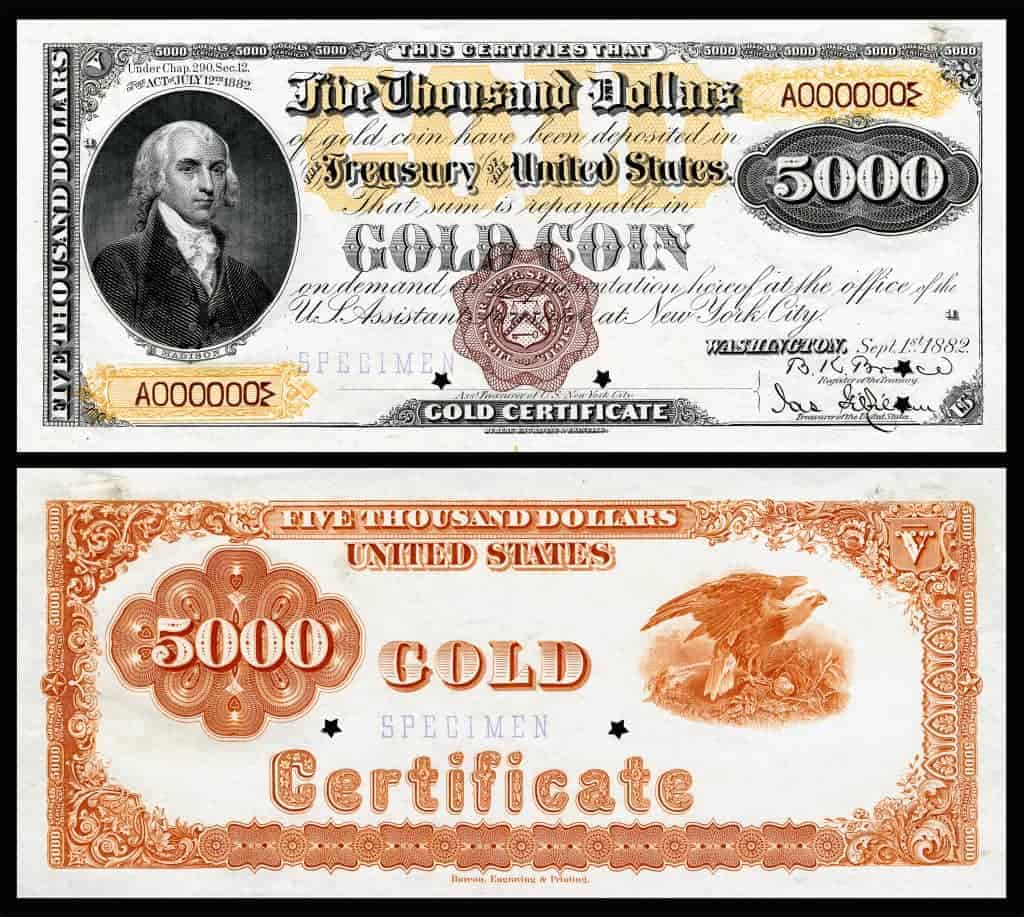
That man is none other than James Madison, the 4th President of the United States. Madison was Thomas Jefferson’s Secretary of State and supervised the Louisiana Purchase from France. He’s also considered the “Father of the Constitution” for being crucial in the drafting the Constitution and championing the Bill of Rights.
This is a gold certificate from 1882. Note the color of the back, you can see why they started nicknaming the later notes as greenbacks.
$500 US Banknote
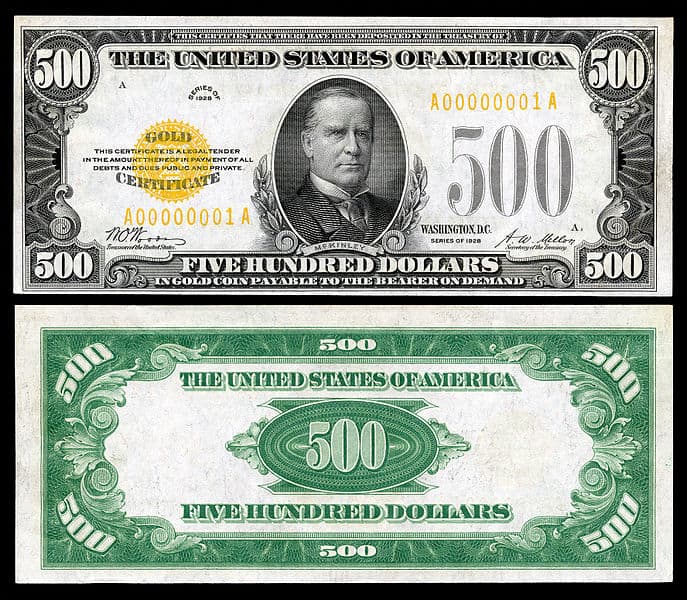
This is another gold certificate but it’s from 1928, which is after the issuance of demand notes and their green back.
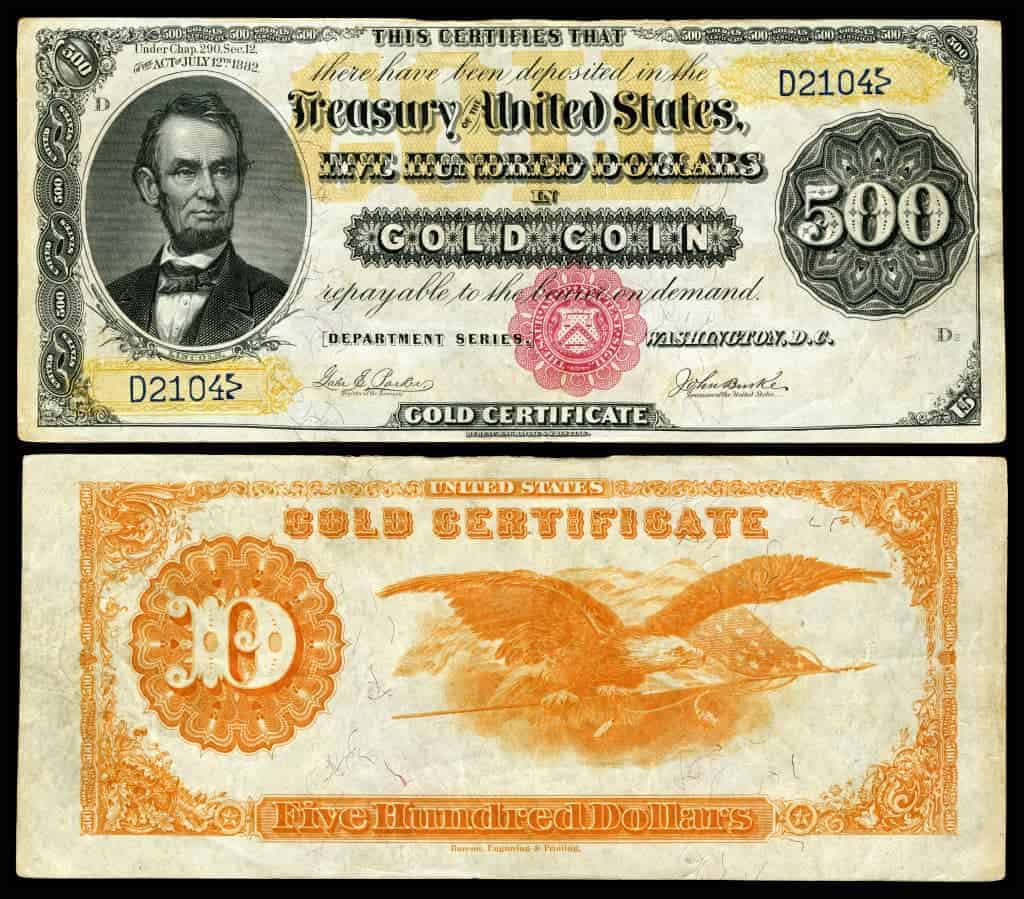
Check out this earlier gold certificate with Abraham Lincoln.
$500 bills were plentiful with a lot of different styles since $500 is far easier to spend than $100,000, wouldn’t you say? You had silver certificates, Federal Reserve Notes, etc. It and the $1,000 notes had the most variation and we won’t show all of them here. You can see the whole list of every large denomination bill on Wikipedia.
My Favorite Bill – The Badass Bald Eagle of the $10,000
This is hands down, my favorite bill. First, it’s $10,000 issued in 1878. The BLS’ CPI calculator only goes back to 1913 and $10k in 1913 is about a quarter-million today. Imagine walking around with a quarter-million-dollar bill in your pocket!
Next, just look at this bad boy:
Love that eagle!
What’s your favorite bill?
Want some more fun? Here are the world’s most exclusive credit cards. Credit cards trimmed in gold, yup, they exist.
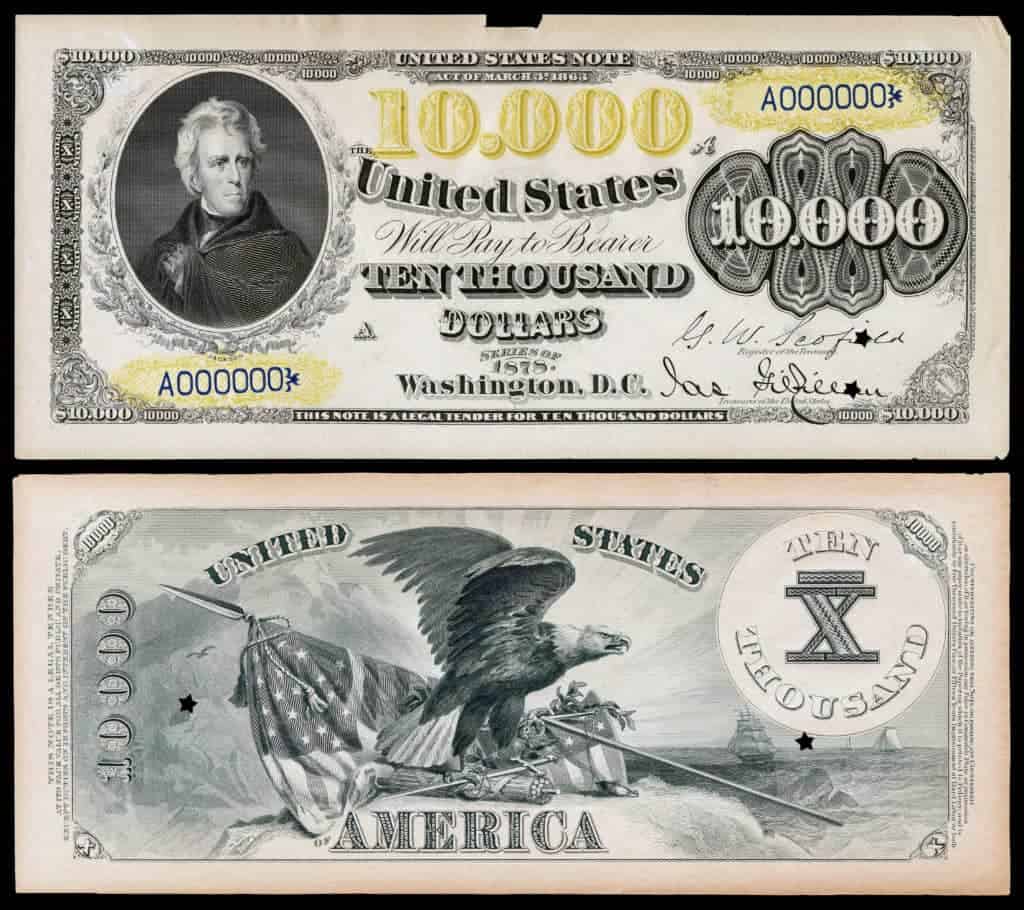




Physician on FIRE says
Those retired bills are pretty nifty. Out of curiosity, do collectors pay substantially more than face value for them?
Although not discontinued, I’ve always been fond of the $2 bill. They’re fun to give in birthday cards and they’re something you don’t see every day. I really liked the Sacagawea dollar coins, too. I’d take a handful to the bar and get weird looks from the bartender.
Everyone seems to like the $2 bill!
Collectors do pay substantially because they’re so rare to find. They also pay more for regular bills with cool serial numbers, stars, etc. People will collect anything.
J. Money says
I have a $500 bill that I traded $1,000 worth of stuff for 🙂 They’re bad ass! (But no – unless there’s something special w/ the $2.00 bill they’re not worth more than face value)
Sam @ Financial Samurai says
Give me the $100,000 bill! lol. I think my previous comment went away. But I’d love to know how much collectors can sell these bills for now.
I collect ancient chinese coins.. picked them up in 1997 in China. Could be worth something!
S
Just moderation, never going to away Sam 🙂
The $100,000 bill is actually illegal for individuals to own!
tgm says
Yeah, I question this. It was used as an inter-agency “money mover” entirely within the federal government and is hence government property, not any form of legal tender, public or bank-internal. And government property has to be returned, HOWEVER: This requirement doesn’t last forever….Past a certain time it becomes part of the various Antiquities Acts. (https://www.doi.gov/museum/laws-and-regulations)
Now the DOI allows for the seizure of artifacts reclaimed from certain archeological sites, with varying degrees of specificity, but it does not allow for immediate seizure of items that can be constituted as records, which is almost certainly what a $100,000 is technically, if argued correctly. Nor can they require that it even be shown in a public museum like they can other artifacts.
In short, if a billionaire came across a $100,000 “bill” that some ancestor of his had purchased from someplace that wasn’t neither considered illegal at the time nor dug up in one of the places listed in the link I provided, then he could likely argue ownership fairly readily.
Brian @ Debt Discipline says
I’m a fan of the two-dollar bill. Might have something to with the fact that I have twins. I also love the stories that pop up every so often about young cashiers who accept them and think they are counterfeit because they’ve never seen them before.
Haha those are the best stories!
Andrew@LivingRichCheaply says
I have a friend who likes using $2 dollar bills to see people’s reactions. Unfortunately, there was a story recently where a 8th grader used it to buy lunch at school and got into some trouble…the police were notified. A little extreme…and kinda sad that none of the adults knew about the existence of a $2 bill.
http://www.forbes.com/sites/kellyphillipserb/2016/05/04/police-called-after-student-tries-to-buy-lunch-with-2-bill/#17de8916cde8
I remember that story… kind of sad really.
Sam @ Financial Samurai says
Wow, beautiful! I love collecting old money and stuff.
Any idea how much these bills can sell for now?
Sam
They vary so widely – so the the $500 “bill,” of which there are like a million varieties (years, gold vs. silver vs Federal Reserve Note) seems one of the more approachable. The $500 Federal Reserve Note from 1934A with McKinley is worth like $700. The 1882 $500 Gold Certificate, which features Lincoln, is very rare and can be worth as much as a few hundred thousand dollars if it’s in really good condition. If it’s not in good condition, only a few thousand.
Bill says
How about $100,000 gold certificate?
That’s an interesting question because technically it can’t be held by collectors so you would never see it sold.
Jack says
Not US currency, but I’m a fan of the trillion dollar bill from Zimbabwe…
Always good to have a reminder that money is just a concept and only worth the faith of the general population gives it.
Great point… that bill looks absurd!
Shaun says
I have seen (and held) a $10,000 bill. My step-father’s uncle passed away recently and had one in his safe!
Two dollar bills are excellent for using as tips. Whoever you give it to will be sure to remember you and likely give you better service.
That’s so cool!
Nathan says
So then what is Sacagawea? She’s been on the dollar coin since 2000 and I’m pretty sure she is still there. I know this Article is about Paper currency, but there was that reference about the Susan B. Anthony dollar coin being the last coin to feature a woman. I have to disagree.
Rod says
If one has a 100000 bill is anyone going to buy it?
And how much does this worth?